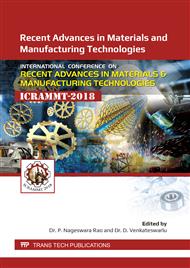[1]
J. Kundrák, A. P. Markopoulos, T. Makkai, N. E. Karkalos, A. Nagy, Multi-objective optimization study in face milling of steel. Proceed. of the Int. Sympos. for Prod. Resea. (2019) 3–15.
DOI: 10.1007/978-3-319-92267-6_1
Google Scholar
[2]
Lamikiz, L. N. L. de Lacalle, O. Ocerin, D. Díez, E. Maidagan, The Denavit and Hartenberg approach applied to evaluate the consequences in the tool tip position of geometrical errors in five-axis milling centres. Int J Adv Manuf Technol 37 (2008) 122–139.
DOI: 10.1007/s00170-007-0956-5
Google Scholar
[3]
D. P. Selvaraj, P. Chandramohan, P. Chandrasekar, Experimental investigations of nitrogen alloyed duplex stainless steel in dry milling process. J. of Engi. Sci. and Technol. 13 (2018) 321 – 331.
Google Scholar
[4]
T. Ozel, T. K. Hsu, E. Zeren, Effects of cutting edge geometry, workpiece hardness, feed rate and cutting speed on surface roughness and forces in finish turning of hardened AISI H13 steel. Int. J. Adv. Manuf. Technol. 25 (2005) 262–269.
DOI: 10.1007/s00170-003-1878-5
Google Scholar
[5]
P. V. Vinay, CH. S. Rao, Experimental analysis and modelling of grinding AISI D3 steel. Int. J. of Recent Adv. in Mecha. Engi. 4 (2015) 47-60.
DOI: 10.14810/ijmech.2015.4105
Google Scholar
[6]
R. Rudrapati, A. Bandyopadhyay, P. K. Pal. Investigation on surface roughness in cylindrical grinding. American Institute of Physics Conf. Proceed. 1315 (2011) 1359-1364.
Google Scholar
[7]
Md. A. P. Ullah, A. K. M. N. Amin, M. D. Arif, Optimization of surface roughness in end milling of medium carbon steel by coupled statistical approach with genetic algorithm. The First Int. Conf. on Interdisci. Resea. and Develop. (2011) Thailand.
Google Scholar
[8]
R. V. Rao. Jaya: A simple and new optimization algorithm for solving constrained and unconstrained optimization problems. Int. J. of Industr. Engi. Comput. 7 (2016) 19–34.
DOI: 10.5267/j.ijiec.2015.8.004
Google Scholar
[9]
J. X. Ren, C. F. Yao, D. H. Zhang, Y. L. Xue, Y. S. Liang, Research on tool path planning method of four-axis high-efficiency slot plunge milling for open blisk. Int. J. Adv. Manuf. Technol. 45 (2009) 101–109.
DOI: 10.1007/s00170-009-2153-1
Google Scholar
[10]
X. FuGui, L. XinJun, Z. Hui, W. JinSong. Design and experimental study of the SPKM165, a five-axis serial-parallel kinematic milling machine. Sci. China Technol. Sci. 54 (2011) 1193–1205.
DOI: 10.1007/s11431-011-4314-3
Google Scholar
[11]
C. Zhang, H. Zhang, Y. Li, L. Zhou, Modeling and on-line simulation of surface topography considering tool wear in multi-axis milling process. Int. J. Adv. Manuf. Technol. 77 (2015) 735-749.
DOI: 10.1007/s00170-014-6485-0
Google Scholar
[12]
T.V. Do, N. A. Vu Le. Optimization of surface roughness and cutting force in MQL hard-milling of AISI H13 steel. LNNS 63 (2019) 448–454.
DOI: 10.1007/978-3-030-04792-4_58
Google Scholar
[13]
R. Rudrapati, P. Sahoo, A. Bandyopadhyay. Parametric optimization in CNC turning of aluminum alloy using hybrid RSM cum TLBO approach. IOP Conf. Series Mate. Sci. and Engg. 149 (2016) 1-13.
DOI: 10.1088/1757-899x/149/1/012039
Google Scholar
[14]
I. P. Okokpujie, O. O. Ajayi, S. A. Afolalu, A. A. Abioye, E.Y. Salawu, M. O. Udo, U. C. Okonkwo, K. B. Orodu, O. M. Ikumapayi, Modeling and optimization of surface roughness in end milling of aluminium using least square approximation method and response surface methodology, Int. J. of Mecha. Engi. and Technol. 9 2018 587–600.
Google Scholar
[15]
R.V. Rao, D.P. Rai, J. Balic, Surface grinding process optimization using Jaya algorithm. Comput. Intellig. in Data Mining 2 (2016) 487-495.
DOI: 10.1007/978-81-322-2731-1_46
Google Scholar
[16]
K. Abhishek, V. R. Kumar, S. Datta, S. S. Mahapatra. Application of JAYA algorithm for the optimization of machining performance characteristics during the turning of CFRP (epoxy) composites: comparison with TLBO, GA, and ICA. Engi. with Comp. 33 (2017) 457–475.
DOI: 10.1007/s00366-016-0484-8
Google Scholar
[17]
R. V. Rao, D.P. Rai, J. Balic, A new optimization algorithm for parameter optimization of nano-finishing processes. Scientia Iranica E 24 (2017) 868-875.
DOI: 10.24200/sci.2017.4068
Google Scholar
[18]
M. Das, R. Rudrapati, N. Ghosh, L. Rathod, Input Parameters optimization in EDM Process using RSM and JAYA Algorithm. Int. J. of Current Engi. and Technol. (2016) 109-112.
Google Scholar
[19]
R. Rudrapati, P. k. Pal, A. Bandyopadhyay, Modeling of surface roughness in cylindrical grinding. Int. J. of Machi. and Machi. of Mate. 12 (2012) 28-36.
Google Scholar


